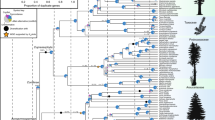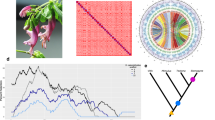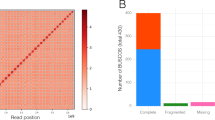Abstract
OF the most highly evolved grasses the most useful to man are chiefly confined to the tropical and the warm temperate regions. For example the Andropogoneae are extensively cultivated for cereals (Sorghum spp.) sugar cane (Saccharum spp.) essential oils (Cymbopogon spp.) and a variety of other purposes. They have attained high adaptive peaks of evolution and species differentiation in the Indo-Malaysian region1 where there is a high or moderately high rainfall. Three species of the Indian grass Iseilema are cultivated for fodder each one of which is a ‘species complex’ or a cluster of chromosome races not randomly united but formed by the genetic system of the taxonomic species. All three complexes show a gradually ascending series of haploid chromosome numbers from 3 to 18 (Table 1) and even the polyploid numbers form an ‘aneuploid’ series within a complex. Selection, environment, polyploidy and B chromosomes have had varying roles in the evolution of these complexes and their most notable characteristic is that they form a self-consistent system of evolutionary mechanisms. Here I demonstrate how Iseilema is indicative of the ancient dibasic polyploidy in its tribe of which it is the highest evolved member in a habitat where the tribe shows maximum diversity and closest adaptation.
This is a preview of subscription content, access via your institution
Access options
Subscribe to this journal
Receive 51 print issues and online access
$199.00 per year
only $3.90 per issue
Buy this article
- Purchase on Springer Link
- Instant access to full article PDF
Prices may be subject to local taxes which are calculated during checkout
Similar content being viewed by others
References
Hartley, W., Aust. J. Bot., 6, 116–128 (1958).
Bor, N. L., The Grasses of Burma, Ceylon, India and Pakistan (Pergamon, Oxford, 1960).
Hooker, J. D., Flora of British India, 7, (Reeve, London, 1897).
Ramana Rao, T. N. V., Curr. Sci., 31, 476–477 (1962).
D'Cruz, R., and Birari, S. P., Curr. Sci., 38, 498–499 (1969).
Celarier, R. P., and Paliwal, R. L., Science, 126, 1247 (1957).
Joshi, A. B., Patil, B. D., and Manchanda, P. L., Curr. Sci., 28, 454–455 (1959).
Ramanathan, K., Curr. Sci., 19, 155 (1950).
Darlington, C. D., and Wylie, A. P., Chromosome Atlas of Flowering Plants (Allen and Unwin, London, 1955).
Hayman, D. L., Aust. J. Bot., 8, 58–68 (1960).
De Wet, J. M. J., OYTON, 15, 37–42 (1960).
de Litardière, R., Compt. Rend. Acad. Sci. Paris., 227, 1071–1072 (1948).
Hutchinson, J., The Families of Flowering Plants, 2, Monocotyledons (Clarendon, Oxford, 1959).
Lewis, H., Int. Union Biol. Sci., B 15, 114–122 (1954).
Uppaluri, R., and Satyavathi, U., J. Bomb. Nat. Hist. Soc., 65, 664–669 (1969).
Author information
Authors and Affiliations
Rights and permissions
About this article
Cite this article
RAO, Y. Evolutionary trends in the Indian Iseilema. Nature 255, 220–221 (1975). https://doi.org/10.1038/255220a0
Received:
Accepted:
Issue Date:
DOI: https://doi.org/10.1038/255220a0
This article is cited by
-
Cytological studies in four species of Mesosetum (Arthropogoninae) reveal the lowest chromosome number among the Neotropical Poaceae
Plant Systematics and Evolution (2015)
Comments
By submitting a comment you agree to abide by our Terms and Community Guidelines. If you find something abusive or that does not comply with our terms or guidelines please flag it as inappropriate.



